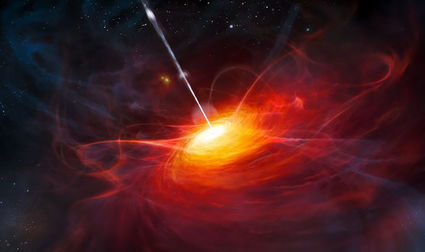UW professor helps develop new model to research activity around quasars, black holes
LARAMIE - A University of Wyoming researcher played a key role in a study that suggests a newly developed computer model can more accurately explain the diversity of quasar broad emission line regions, which are the clouds of hot, ionized gas that surround the supermassive black holes feeding in the centers of galaxies.
November 9, 2017

COURTESY/UW/European Southern Observatory/M. Kornmesser Photo
Michael Brotherton, a UW professor of astronomy, played a key role in a study, published in Nature Astronomy, that suggests a newly developed computer model can more accurately explain the diversity of quasar broad emission line regions, which are the clouds of hot, ionized gas that surround the supermassive black holes feeding in the centers of galaxies. This artist's impression shows how ULAS J1120+0641, a very distant quasar powered by a black hole with a mass 2 billion times that of the sun, may have looked. This quasar is the most distant yet found and is seen as it was just 770 million years after the Big Bang.
LARAMIE - A University of Wyoming researcher played a key role in a study that suggests a newly developed computer model can more accurately explain the diversity of quasar broad emission line regions, which are the clouds of hot, ionized gas that surround the supermassive black holes feeding in the centers of galaxies.
"We are trying to get at more detailed questions about spectral broad-line...
For access to this article please
sign in or
subscribe.


